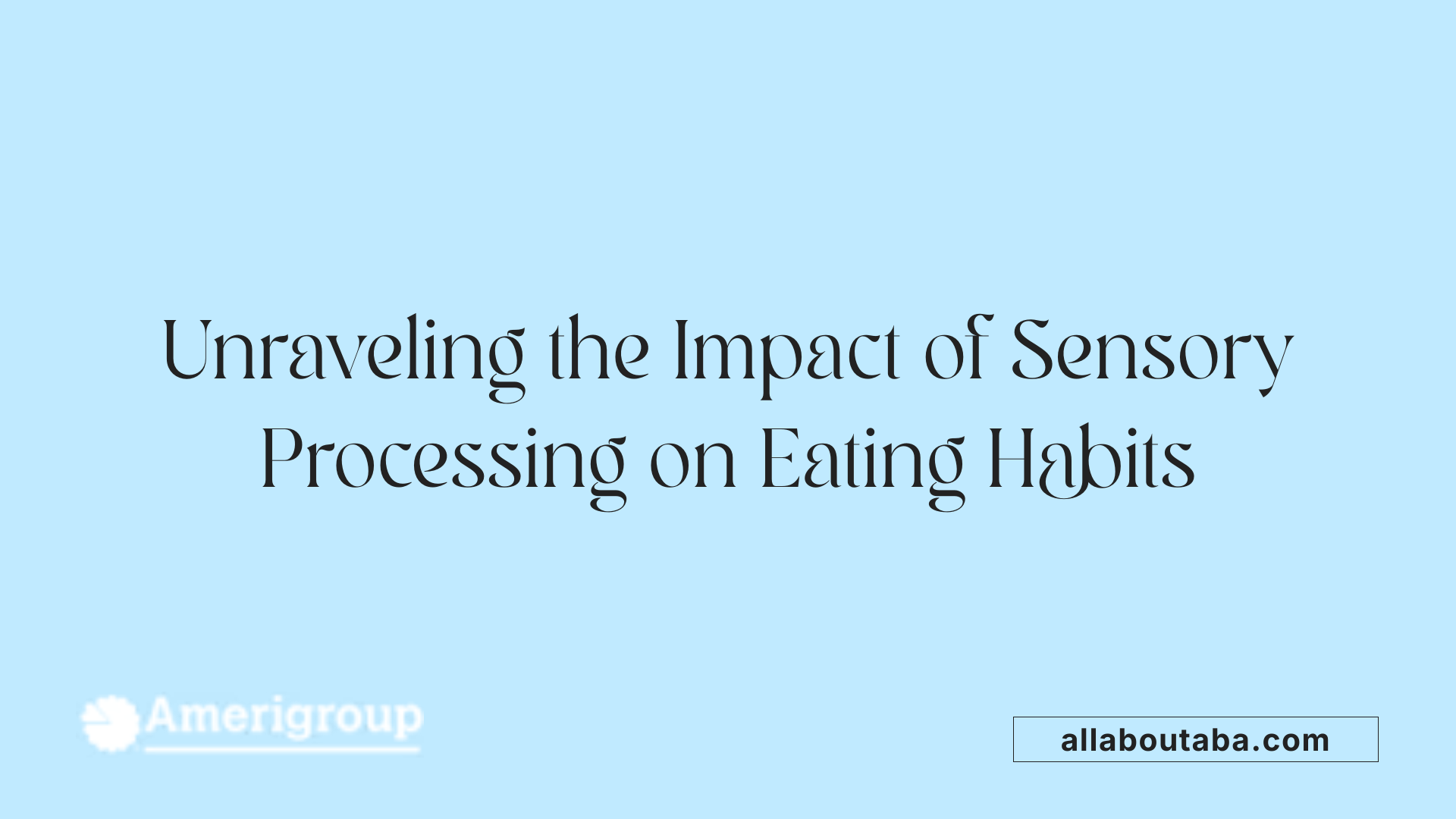Autism And Eating Challenges Beyond Picky Eating
Understanding the Multifaceted Eating Challenges in Autism
Eating behaviors in individuals with autism spectrum disorder (ASD) often go far beyond the typical notion of picky eating. These challenges involve a complex interplay of sensory sensitivities, rigid routines, biological factors, and behavioral patterns that can significantly affect nutrition and quality of life. This article explores the varied nature of these eating difficulties, the underlying causes, and effective evidence-based interventions, with a special focus on the role of behavioral analysis therapy in addressing and improving feeding behaviors in autism.
The Spectrum of Eating Challenges in Autism

What eating challenges are commonly observed in individuals with autism?
Eating challenges are a notable concern among individuals with autism spectrum disorder (ASD). A significant number—estimated between 46% and 89%—experience food selectivity, which manifests as rigid, ritualistic eating behaviors and narrow food preferences. These behaviors often come with strong emotional reactions such as tantrums during meals, making mealtime a challenging experience.
How do sensory processing issues impact eating in autism?
Sensory processing differences play a central role in eating difficulties for many with autism. Children may be hypersensitive or under-sensitive to sensory stimuli related to food. Characteristics such as texture, color, smell, shape, temperature, and food organization can influence acceptance or rejection. For instance, a child might refuse foods that are too crunchy, strongly scented, or visually unfamiliar, leading to a very limited diet.
What are common feeding difficulties and behaviors in children with autism?
Children with autism commonly display specific feeding behaviors including:
- Refusal of a broad range of foods or insistence on very limited types, often pureed or finger foods
- Strong preferences for certain brands or food preparation methods
- Disruptive mealtime behaviors such as spitting, tantrums, or refusing to bite
- Demand for specific utensils or conditions during meals
These behaviors can increase parental stress and complicate attempts to diversify the diet.
How do gastrointestinal symptoms affect food intake?
Nearly half of children with ASD experience gastrointestinal (GI) symptoms such as constipation, diarrhea, abdominal pain, vomiting, and bloating. These uncomfortable or painful symptoms can exacerbate food avoidance and intensify selectivity. The association of eating with discomfort can reinforce negative feeding behaviors and reduce nutrient intake.
| Aspect | Description | Impact on Eating Habits |
|---|---|---|
| Food Selectivity | Narrow preferences, ritualistic habits, tantrums around meals | Limited diet diversity, risk of nutritional deficiencies |
| Sensory Processing Issues | Hypersensitivity or under-sensitivity to food texture, smell, color, temperature | Food refusal linked to sensory discomfort |
| Feeding Behaviors | Food refusal, preference for certain textures, disruptive behaviors like spitting or tantrums | Emotional meal disruption, difficulty introducing new foods |
| Gastrointestinal Symptoms | Constipation, diarrhea, bloating, abdominal pain, vomiting | Can cause or worsen food avoidance and feeding difficulties |
Sensory Processing and Eating: The Hidden Barrier

How do sensory processing issues influence eating in autism?
Sensory processing difficulties are widespread in children with autism and significantly shape their eating behaviors. Many children experience hypersensitivity or under-sensitivity to stimuli such as textures, smells, tastes, and colors of food. This can make certain foods seem unbearable or unpleasant, leading to food aversions and a highly selective diet.
For example, a child might reject foods based on their smell or how they feel in the mouth, which can result in a very limited range of foods accepted and difficulty expanding their diet. These sensory challenges often cause stress and anxiety around mealtimes, as the environment and food characteristics clash with sensory preferences.
Common food sensory triggers in autism
Children with autism may be particularly sensitive to:
- Texture (e.g., crunchy vs. soft, slimy vs. dry)
- Smell (strong or unfamiliar aromas)
- Taste (intensity or bitterness)
- Appearance (color, shape, or how food is presented)
- Temperature (extreme hot or cold) These sensory triggers can provoke avoidance behaviors, refusal to eat, or negative mealtime rituals such as specific food arrangements or rigid eating routines.
The role of sensory integration in therapy
Occupational therapists often use sensory integration techniques to address these eating challenges. Through controlled, gradual exposure to different textures, smells, and tastes, therapy aims to desensitize children to aversive sensory experiences.
Approaches include encouraging slow acceptance of new food properties combined with play and positive reinforcement. Sensory integration therapy builds tolerance over time, helping children expand their diets and reduce mealtime anxiety.
Together, understanding sensory processing and applying targeted interventions can significantly improve eating behaviors and nutritional outcomes for children with autism.
Biological and Environmental Contributors to Feeding Difficulties
What biological and environmental factors influence feeding problems in autism?
Feeding difficulties in children with autism often stem from a combination of biological and environmental factors. On the biological side, gastrointestinal (GI) problems are prevalent. Nearly half of children with autism experience symptoms like constipation, diarrhea, abdominal pain, vomiting, and trouble swallowing. These issues can make eating uncomfortable or painful, causing children to avoid specific foods.
Physical conditions also play a role. Issues such as short gut syndrome, palate defects, oral motor dysfunctions, and dysphagia can significantly interfere with a child's ability to eat normally. These challenges may reduce the variety and quantity of foods they consume, complicating nutrition and growth.
Environmental and social influences further impact feeding behaviors. Noisy, crowded, or unpredictable mealtime environments can heighten anxiety and discomfort. Many children with autism develop strict routines around eating, including preferences for certain food brands, specific preparation methods, or particular utensils, which help provide predictability and reduce stress during meals.
Together, these biological and environmental factors create complex feeding challenges requiring a comprehensive approach for effective management.
Health Risks Associated with Limited Diets in Autism
What health concerns arise from the limited diets of individuals with autism?
Limited diets common among individuals with autism often result in several health challenges. Selective eating behaviors can lead to significant nutritional deficiencies. This includes a lack of essential vitamins, minerals, and proteins necessary for proper physical growth and cognitive development.
Additionally, some individuals may fill their limited food variety with high-sugar or processed foods. This dietary pattern raises the risk of obesity, which brings its own set of health complications such as cardiovascular issues and diabetes.
These nutritional imbalances can result in growth failure, greater vulnerability to chronic illnesses, and an overall decline in health status. The risk underscores the critical importance of monitoring dietary intake and implementing balanced nutrition plans.
Healthcare professionals often emphasize the need for tailored interventions to address these dietary gaps. Structured nutritional assessments and individualized diet plans can help manage these risks and promote healthier outcomes.
In summary, the combination of nutrient deficiencies and obesity risks in autism highlights the complexity of managing eating habits. A balanced diet that meets diverse nutritional needs is essential for supporting optimal development and well-being in individuals with autism.
Behavioral Analysis Therapy: A Science-Based Intervention for Eating Challenges

What is behavioral analysis therapy for autism?
Behavioral analysis therapy for autism, commonly known as Applied Behavior Analysis (ABA), is a science-based method designed to understand and change behaviors by applying learning principles. ABA focuses on increasing positive behaviors and reducing problematic ones using reinforcement and behavior modification techniques. It is personalized to each individual through detailed functional assessments and continuous monitoring of progress.
How does ABA address feeding issues in children with autism?
ABA effectively addresses feeding challenges by targeting specific behaviors related to eating, such as food refusal, tantrums, and selective eating. Behavior analysts identify the reasons behind these behaviors—whether sensory sensitivities, avoidance, or reinforcement patterns—and craft intervention plans that gradually increase food acceptance. ABA aims to improve eating routines, expand food variety, and reduce anxiety around mealtime by creating predictable and positive environments.
Techniques and strategies used in ABA for feeding challenges
Several specialized strategies are employed in ABA to tackle feeding difficulties:
- Positive Reinforcement: Rewarding desired eating behaviors to increase their frequency.
- Shaping: Gradually encouraging closer approximations of the target behavior, such as tasting new foods.
- Food Chaining: Introducing new foods related in texture or flavor to preferred foods to ease acceptance.
- Systematic Desensitization: Slowly exposing children to aversive textures or smells to reduce sensory sensitivities.
- Escape Extinction: Preventing avoidance behaviors to reduce food refusal.
- Visual Supports and Social Schedules: Using structured routines to build predictability and reduce mealtime anxiety.
A Board Certified Behavior Analyst (BCBA) typically develops tailored feeding plans based on comprehensive assessments. They also train caregivers to implement these strategies consistently at home, ensuring long-term success.
ABA's evidence-based framework has demonstrated success in helping up to 90% of children with autism overcome feeding difficulties, promoting healthier eating habits and nutritional intake over time.
Providers and Implementation of Behavioral Analysis Therapy
Who typically provides behavioral analysis therapy for individuals with autism?
Behavioral analysis therapy for autism is primarily provided by Board Certified Behavior Analysts (BCBAs). These professionals have specialized training in Applied Behavior Analysis (ABA) and create individualized feeding and behavioral plans tailored to each child's unique needs. They oversee therapy implementation and conduct functional assessments to understand eating challenges.
Interdisciplinary collaboration
BCBAs often collaborate with other specialists such as speech-language pathologists, occupational therapists, and licensed psychologists. This interdisciplinary team uses a bio-psycho-social approach to comprehensively address feeding challenges, combining expertise in sensory integration, oral-motor skills, and behavior management.
Family involvement and support
Family participation is critical to the success of ABA interventions. BCBAs train caregivers to implement strategies consistently at home, reducing mealtime stress and reinforcing positive eating behaviors. Support groups and professional guidance further empower families, ensuring a calm, structured, and predictable environment that fosters gradual dietary expansions and better nutrition for children with autism.
Effective ABA Strategies for Managing Eating Challenges
Functional assessments and intervention planning
Applied Behavior Analysis (ABA) therapy starts with thorough functional assessments by Board Certified Behavior Analysts (BCBAs) to determine the reasons behind feeding difficulties in children with autism. These assessments examine the functions of behaviors during mealtime, such as whether food refusal is reinforced by escaping unpleasant stimuli or by gaining attention. Based on this understanding, individualized behavior intervention plans (BIPs) are created. These plans focus on modifying antecedents, teaching new eating behaviors, replacing problem behaviors like tantrums or spitting, and reinforcing positive eating habits.
Techniques like positive reinforcement and shaping
Positive reinforcement is a cornerstone of ABA strategies, where desirable eating behaviors are rewarded to increase their occurrence. Shaping involves reinforcing successive approximations toward the target behavior — such as tolerating new food textures or taking bites of unfamiliar foods. Differential reinforcement distinguishes between appropriate and inappropriate behaviors, reinforcing the desired actions while decreasing unwanted responses. Additionally, escape extinction techniques prevent the child from avoiding food exposures, gradually building tolerance.
Specific ABA methods for feeding such as food chaining and escape extinction
Food chaining is a gradual approach that expands a child's diet by linking new foods to preferred ones through shared flavors, textures, or shapes. The "tiny taste" rule, often used with the First-Then principle, encourages trying small amounts of new foods followed by preferred rewards, making the process engaging and less stressful. Escape extinction reduces refusal behaviors by preventing avoidance while non-contingent positive reinforcement provides attention independent of compliance to minimize problematic actions. Visual supports and structured routines also help maintain predictability, reducing mealtime anxiety.
ABA therapy benefits individuals with autism by systematically increasing desirable eating behaviors and reducing negative or avoidant responses. Through functional assessments, BCBAs identify the causes and functions of feeding difficulties and craft behavior intervention plans (BIPs) that modify antecedents and teach replacement behaviors. Techniques such as positive reinforcement, shaping, escape extinction, and differential reinforcement encourage acceptance of new foods and reduce problematic behaviors. Methods like food chaining and the "tiny taste" rule use gradual exposure and reinforcement to expand dietary variety, leading to improved nutrition and mealtime cooperation.
Supporting Families and Managing Mealtime Stress

Family Education and Emotional Support
Family involvement is foundational in managing eating challenges associated with autism. Educating caregivers about feeding difficulties not only equips them with effective behavioral strategies but also helps reduce stress during mealtimes. Validation of families' experiences and emotional support foster resilience and patience, which are essential in navigating picky eating and food aversions common in children with autism.
Creating Predictable and Calm Mealtime Environments
Children with autism thrive in structured settings. Maintaining consistent and predictable mealtime routines significantly reduces anxiety and resistance around eating. A calm environment paired with gradual introductions of new foods can alleviate sensory overload and behavioral challenges. Avoiding sudden changes and minimizing distractions further supports successful eating experiences.
Use of Visual Supports and Routine
Visual aids such as social schedules or picture-based menus help children understand expectations and sequence during meals. Incorporating these tools enhances communication and engagement, making mealtimes less stressful. Consistently reinforcing predictable routines and gradually modifying them supports tolerance for change while promoting acceptance of diverse foods.
By combining family education, structured environments, and visual supports, caregivers can effectively manage mealtime behaviors in children with autism. This comprehensive approach fosters positive eating habits, supports nutritional health, and lowers the emotional toll on families, ultimately contributing to improved quality of life for both children and caregivers.
A Patient, Long-Term Approach for Lasting Success
What approaches lead to effective long-term improvements in eating behaviors for children with autism?
Addressing eating challenges in children with autism demands a gradual, consistent, and patient strategy. This approach respects their sensory sensitivities and unique behavioral patterns.
Gradual introduction of new foods and careful texture modifications help prevent overwhelming the child. Slowly exposing children to different tastes, smells, and textures while avoiding sudden changes reduces distress and negative reactions to unfamiliar food.
Crucially, avoiding negative reinforcement of avoidant behaviors is essential. Caregivers should not inadvertently reward food refusals or tantrums, as this can reinforce picky eating. Instead, positive reinforcement techniques should encourage acceptance and exploration of new foods.
Balancing sensory and behavioral techniques is effective. Sensory integration therapies can desensitize children to aversive food characteristics, such as texture or smell, while applied behavior analysis (ABA) helps shape eating behaviors through rewards, routines, and systematic desensitization.
Creating calm, predictable mealtime environments with consistent routines reduces anxiety and resistance. Visual schedules, social stories, and small, manageable steps further support children's engagement and cooperation.
Family involvement and professional guidance are pivotal to success. Consistency across settings, combined with encouragement and patience, leads to sustainable dietary improvements. This long-term tailored approach not only expands food acceptance but also supports the child’s overall health and development.
Navigating the Complex Landscape of Autism and Eating Difficulties
Eating challenges in autism encompass far more than mere picky eating, involving multifaceted sensory, behavioral, biological, and environmental factors that can deeply affect nutrition and wellbeing. Applied Behavior Analysis stands out as a scientifically validated, versatile approach that addresses these challenges through individualized, systematic therapies focusing on behavior modification and skill development. Successful management depends on interdisciplinary care, family collaboration, and patience, supporting individuals with autism to expand their diets, improve health, and enjoy more fulfilling mealtime experiences. Recognizing and addressing these complexities empowers caregivers and professionals to make meaningful, lasting progress beyond conventional perceptions of picky eating.
References
- Does Autism Affect Eating Habits?
- Information on Picky Eating in Children with Autism
- Food Challenges and Children with Autism
- Tackling Picky Eating: Nutrition Tips for Autistic Children
- ABA for Picky Eaters with Autism: Techniques
- Applied Behavior Analysis and Pediatric Feeding Disorders
- Applied Behavior Analysis (ABA)
- The Top 10 Reasons Children With Autism Deserve ABA
- Applied Behavior Analysis (ABA)
- 6 Benefits of ABA Therapy for Children with Autism
Other articles
Recent articles

Autism And Eating Challenges Beyond Picky Eating

Best Practices For Autism-Friendly Public Transport Design

Best Ways To Foster Collaboration Between Parents And Schools For Autism Support

Supporting Autistic Children During Transitions Between Activities

The Role Of Teachers In Fostering Autism Peer Acceptance

Using Art Therapy To Support Children With Autism

Autism And Strategies For Addressing Sensory Defensiveness

Autism And The Benefits Of Structured Leisure Activities

How To Support Autistic Students During Exam Season

Autism And Goal Setting For Personal Growth

How To Use Gamification In Autism Learning Programs

How Schools Can Reduce Bullying Of Autistic Students

Early Intervention Strategies For Autism Spectrum Disorder

The Role Of Therapists In Autism Life Skills Coaching

How To Support Autistic Individuals In Crisis Situations

Autism And Self-Care Routines For Stress Management

Understanding Echolalia And Its Role In Autism Communication

Autism And Fine Arts Education Benefits

The Impact Of Multisensory Learning On Autism Education

How Family Counseling Supports Autism Household Dynamics

Best Practices For Inclusive Playgrounds For Autism

Best Practices For Autism-Friendly Shopping Centers

How Autism Affects Fine Motor Skill Development

Best Ways To Introduce Sensory Activities Into Daily Routines

How Sports Teams Can Be Inclusive Of Autistic Players

Autism And Strategies For Building Workplace Resilience

Autism And The Impact Of Hormonal Changes During Puberty

How To Support Autistic Students In Foreign Language Classes

Best Ways To Teach Money Skills To Teens With Autism

Supporting Siblings Of Children With Autism

Autism And Co-Occurring Gastrointestinal Disorders

The Role Of Art Projects In Autism Sensory Integration

How Schools Can Incorporate Sensory Break Spaces

Best Practices For Autism Sensory Regulation At School

Autism And Strategies For Teaching Organizational Skills

Understanding The Relationship Between Autism And Anxiety Disorders

Autism And Life Planning For Long-Term Care

Exploring Visual Supports In Autism Education

Ways To Encourage Social Interaction In Children With Autism

The Connection Between Autism And Dyscalculia

The Role Of Occupational Therapy In Transition Planning For Autism

The Role Of Physical Therapists In Autism Motor Skills Support

How To Teach Decision-Making Skills To Autistic Young Adults

The Connection Between Autism And Epilepsy

Best Practices For Transitioning Autistic Children Into New Schools

Autism And Time Management Challenges In Adulthood

The Role Of Visual Arts In Autism Communication Development

How To Address Tactile Defensiveness In Autism

Best Practices For Telehealth Autism Therapy

How To Help Autistic Children Develop Friendship Skills

How Schools Can Support Autistic Students In Career Prep

Best Strategies For Autism-Friendly Event Planning

Understanding Noncontingent Reinforcement In Autism Behavior Plans

How Drama Therapy Benefits Autistic Individuals

Best Practices For Autism-Friendly Fitness And Recreation Centers

Best Ways To Promote Healthy Social Media Use For Autistic Teens

How To Help Autistic Children Cope With Public Speaking

Autism And Strategies For Managing Unexpected Changes

Best Podcasts About Autism For Parents And Educators

Autism And The Impact Of Seasonal Changes On Behavior

The Role Of Diet In Managing Co-Occurring Conditions With Autism

Sleep Challenges In Autism And Practical Solutions

Best Ways To Build Daily Routines For Autistic Children

Best Practices For Supporting Autistic Entrepreneurs

Autism And Strategies For Navigating Large Social Gatherings

Adaptive Sports And Recreational Activities For People With Autism

Autism And The Benefits Of Story-Based Learning Activities

Understanding The Role Of Play In Autism Development

Autism And The Impact Of Environmental Noise On Learning

How To Create Autism-Friendly Community Spaces

Autism And Chronic Health Conditions: What To Know

The Role Of Care Managers In Autism Life Planning

How To Teach Social Boundaries To Autistic Children

How Autistic Individuals Experience Empathy Differently

How To Support Autistic Employees In Remote Work Settings

Autism And The Relationship Between Motor Skills And Learning

How To Create Community Resource Guides For Autism Families

How To Teach Daily Living Skills To Autistic Teens

Autism And The Impact Of Mind-Body Practices On Stress Reduction

Autism And The Benefits Of Outdoor Group Activities

How To Create Autism-Friendly Sensory Paths In Schools

Best Practices For Autism-Friendly Park And Recreation Areas

Autism And Strategies For Reducing School Refusal

Supporting Autistic Individuals In Public Speaking

The Role Of Diet In Managing Autism Symptoms

The Benefits Of Gardening Clubs For Autism Social Development

How To Prepare Autistic Children For Dental Visits

Autism And Employment: Career Paths That Work

Best Practices For Autism-Friendly Hotels And Lodging

The Impact Of Screen Time On Autism Development

Autism Screening Tools For Early Childhood

The Role Of Physical Exercise In Autism Therapy

Best Strategies For Supporting Autistic College Students

The Role Of Technology In Autism Early Detection

Sensory-Friendly Classroom Design Ideas For Autistic Students

The Role Of Speech Therapy In Building Social Communication Skills

Best Strategies For Handling Autistic Burnout In Adults

Autism And The Importance Of Predictability In Routine

Autism And Peer Education: Teaching Acceptance In Schools

Best Practices For Sensory-Friendly Libraries And Reading Rooms
We’re All About You, Your Family, and Your Child

